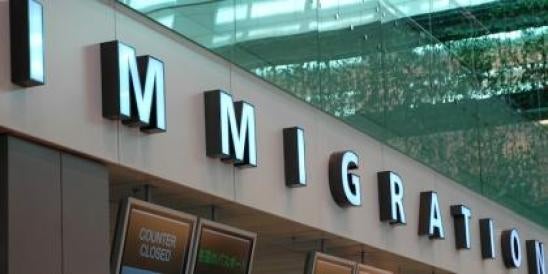I. H-1B Nonimmigrant Season Opens on April 1, 2015, for Fiscal Year 2016
As most H-1B employers know, there is an annual quota on the number of new H-1B petitions that can be approved each federal fiscal year. The quota is 65,000 for regular H-1B petitions, plus another 20,000 for H-1B petitions filed for foreign nationals (“FNs”) who have obtained a master’s degree or higher from an accredited American university. The federal government’s fiscal year runs from October 1 through September 30, so fiscal year 2016 will begin on October 1, 2015. Employers are eligible to start filing H-1B petitions toward the fiscal year 2016 quota on April 1, 2015, but they cannot secure a start date prior to October 1, 2015.
As the U.S. economy improves, the likelihood is that more employers will submit H-1B petitions for inclusion in the 2016 H-1B quota. Last year, the quota was reached during the first week that petitions were accepted. This year, predictions are that there will be even more new H-1B petitions, so the probability of securing a coveted H-1B quota number will be less. Thus, employers need to assess their workforce requirements, determine what H-1B petitions they plan to file, and get them submitted on April 1, 2015. Given the likelihood that the majority of these petitions will not be accepted, employers also need to plan now on what options, if any, are available to those FN employees whose petitions are not accepted.
II. President Obama Issues Executive Order on Immigration
On November 20, 2014, President Obama announced that he was issuing an Executive Order that would improve the nation’s admittedly broken immigration system (“Executive Order”). While the announcement was long on promises, the Executive Order was short on concrete and immediate actions in any area that the President sought to reform. Thus, while we can describe the broad proposals made by the President, we cannot point to any specific change in the immigration process or procedure that will affect our clients within the near future.
The Executive Order basically addressed three separate aspects of the immigration process. First, it sought to establish new enforcement priorities regarding the apprehension, detention, and removal of undocumented aliens. This part of the process would focus on removing aliens who are threats to national security, border security, and public safety, including aliens who have been convicted of more serious crimes. However, for those aliens who do not fit these criteria and are not dangerous, the Executive Order promised that the government would use its prosecutorial discretion to decide whether these aliens would be allowed to remain and work in the United States.
Second, the Executive Order promised certain business immigration reforms. The President ordered the U.S. Citizenship and Immigration Services (“USCIS”) and Department of State (“DOS”) to modernize and improve the employment-based immigrant visa system. He also promised to reform the process for securing and extending Optional Practical Training (“OPT”) so that FNs graduating from U.S. universities do not have to leave the country if they have not secured an H-1B visa due to the quota limit. Further, the President directed the USCIS to adopt new rules providing for increased job “portability” for those workers who are mired in the green card process, develop rules that would give more consistency and predictability to the L-1B classification due to its importance to multinational organizations, and finalize and issue regulations that would allow the H-4 spouses of these FNs to work while their green card cases are pending. Also, the President directed the U.S. Department of Labor to modernize the PERM labor certification program.
Finally, the Executive Order directed all the federal agencies responsible for worker protections to establish an interagency working group that will identify policies and procedures that promote the consistent enforcement of the laws and regulations that apply to the workforce. However, this presidential direction may subject employers to a disproportionate amount of difficulty due to the amorphous nature of the proposals in the Executive Order and a lack of direction.
III. States Sue to Enjoin the Executive Order
Almost before the ink was dry on the Executive Order, 17 states filed a lawsuit in a federal district court in Texas on December 3, 2014, to enjoin its enforcement. Texas v. United States, Case No. 1:14-cv-00254 (S. D. Tex. 2014). This lawsuit claims that the Executive Order was an unconstitutional exercise of executive power that violated both the Take Care Clause of the U.S. Constitution and the Administrative Procedure Act. These plaintiffs seek an injunction that would prohibit the federal government’s use of prosecutorial discretion to allow undocumented workers to remain and work in the United States.
In an unrelated case, a federal district court in Pennsylvania found that the Executive Order was unconstitutional in so far as it purported to prevent the conviction of a defendant in a criminal case. United States v. Juarez-Escobar, No. 2:14-cr-00180 (W.D. Pa. Dec. 16, 2014). The Juarez-Escobar case involved the criminal prosecution of an undocumented alien who had been deported but subsequently had unlawfully returned to the United States. The defendant argued that the Executive Order created an additional defense to prosecution, and the court directed the parties to brief the issue. The government claimed that the Executive Order did not provide a potential defense because it addressed only enforcement priorities for civil removal cases. Notwithstanding the government’s position, the court concluded that the defendant could not claim any benefit under the Executive Order because it was an unconstitutional exercise of executive action. Given the unusual manner in which this decision was rendered, it is unclear what precedential value, if any, it may have. It is clear, however, that the Juarez-Escobar case will add to the debate on the President’s controversial executive action.
IV. Federal Court in the District of Columbia Allows Worker Challenge to OPT Program
On November 21, 2014, a federal district court judge in the District of Columbia rejected a motion to dismiss a lawsuit brought by a union and several information technology (“IT”) workers who challenged the legality of the 17-month OPT work program for foreign students. See Washington Alliance of Technical Workers v. DHS, Civil Action No. 14-529 (ESH)(D.D.C. Nov. 21, 2014). As many of our readers know, federal regulations allow FNs in OPT status to extend that status for an additional 17 months if they have a degree in Science, Technology, Engineering, or Mathematics (“STEM”) and their employer is registered and using the federal E-Verify program to confirm the identity and work authorization of all new employees in the location where they will work.
In the Washington Alliance case, the plaintiffs claimed that the OPT program was unlawful because it created a lower wage class of labor that unfairly undercut the wages that they received. In part, the plaintiffs’ claims rested on the fact that FNs working on OPT status are exempt from prevailing wage requirements as well as Medicare and Social Security taxes, and this makes them less expensive to employ. Based on the allegations in the complaint, the district court found that the plaintiff IT workers were in direct competition with OPT students and, thus, had standing to challenge the program.
While this lawsuit was filed prior to the Executive Order, it may have an impact on the President’s proposals to expand the OPT program. At a minimum, this lawsuit is another element in the immigration litigation minefield that the administration must navigate before the Executive Order can take effect.
V. DOS Issues New J-1 Rules for 2015
On October 6, 2014, the DOS issued a final rule (“Final Rule”) amending its general rules regarding administration of the J-1 Exchange Visitor Program. This program covers a diverse group of cultural exchanges by which FNs to come to the United States temporarily to gain practical experience, train, or intern for American employers. To qualify for the J-1 classification, the FN must, among other things, demonstrate English language proficiency. The Final Rule established new testing and documentation requirements that must be satisfied to establish English proficiency. This new language requirement took effect on January 5, 2015.
Also in the Final Rule, the DOS increased the amount of insurance coverage that program participants are required to maintain. Specifically, an acceptable insurance plan now must provide the following:
medical benefits of at least $100,000 per accident or illness (formerly $50,000);
repatriation of remains in the amount of $25,000 (formerly $7,500);
expenses associated with the medical evacuation of exchange visitors to his or her home country in the amount of $50,000 (formerly $10,000); and
deductibles not to exceed $500 per accident or illness.
These new insurance coverage requirements took effect on January 1, 2015. However, J-1 sponsors have until May 15, 2015, to increase their levels of insurance coverage to the new amounts.
VI. DOS Issues January 2015 Visa Bulletin
The DOS has issued its Visa Bulletin for January 2015. This bulletin determines who can apply for U.S. permanent residence and when. The cutoff dates for family-based immigration continue to show backlogs and regressions due to the heavy demand for these visas. On the employment-based side, the January 2015 Visa Bulletin showed that the employment-based second (“EB-2”) preference for China advanced to February 1, 2010, but India remained at February 15, 2005. The EB-2 cutoff date for the rest of the world remained current. In the January 2015 Visa Bulletin, the cutoff dates for the employment-based third (“EB-3”) preference category are as follows: June 1, 2013, for all chargeability, including Mexico and the Philippines; March 1, 2011, for China; and December 15, 2003, for India.




 i
i

